Gloucester Cathedral
Gloucester, Gloucestershire
|

Feature Location Guide |
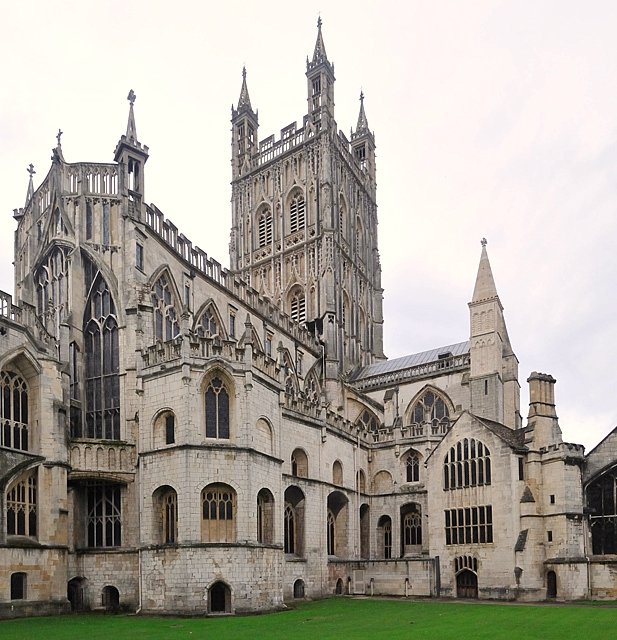

Gloucester Cathedral stands on the site of an
early monastery established in 678 or 679. The present abbey church was created
between 1072 and 1104 as a part of a Benedictine monastery. Gloucester is one of
6 former monasteries that were re-founded as cathedrals in the period of Henry
VIII. It was probably selected as it has the tomb of a former English King,
Edward II, and the coronation took place here of Henry III.
It is said that a small religious community
was founded here in Saxon times, 678-9, by Osric of the Hwicce. Kyneburga, his
sister, or possibly great aunt, was the first Abbess. Osric also founded Bath
abbey. In a charter that was apparently issued in the 670's by Æthelred, king of
Mercia, it records his grant of lands at Gloucester and Pershore to two of his
thegns, noblemen of the Hwicce, Osric and his brother Oswald. Osric's share was
at Gloucester and he sought permission from Æthelred to found a monastery there.
The Charter of Gloucester treats Osric as a subordinate of Æthelred, where the
Charter of Bath (676) describes him as King of the Hwicce. He is also described as a
King by Bede. Osric was buried in Gloucester Cathedral/Abbey.
| We don't know what order this early religious
house belonged to, or if it was a part of the Celtic or Roman branches of
Christianity. William of Malmesbury says that Bath Abbey was built on an earlier
pagan temple, and that later, it converted to the rule of St Benedict after 968,
suggesting it was part of the earlier Celtic Christianity before. If Bath was
originally a part of the original Celtic form of Christianity in Britain its
very likely that the first Gloucester monastery was as well. In 1017 the secular priests then running the
monastery were expelled and it was given to Benedictine monks, led by a Norman
monk. In the next twenty years the assets of the abbey was to double, by
'recovering' income from existing estates. This funded the rebuilding of the
abbey. It was prosperous and building and expansion continued through to the
period of Henry VIII. The size and number of people was thinned out by
converting it to a cathedral, but the church remained basically unaltered.

|
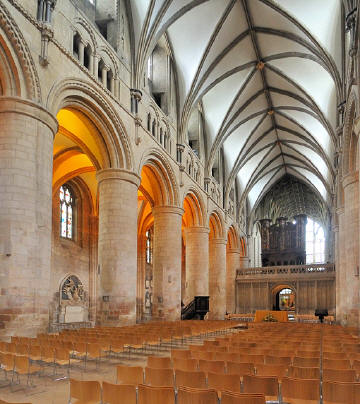
|
Today we have a unique glimpse back in time,
with its Norman naive with huge round columns, 6 foot across and 32ft high, low
circular arches and Roman looking architecture form this early period. It also
features probably the most spectacular and complete cloisters that can be seen
anywhere in the UK. The naive may look large but uses up only around half
of the main part of the cathedral, beyond the screen, is the choir, and beyond
this an area that can be reached from either side isle, before you get to the
great east window, as large as a tennis court, and the largest window in
existence when it was created. Going even further east under this, is the
entrance to the expanded lady chapel, added at the end of the 15th century. This
is very light and has far more glass than walls on all sides. A large ornate
tower stretches up 225 feet, with below the eastern end, a crypt that is one of
only four apsidal cathedral crypts in England, the others being at Worcester,
Winchester
 and
Canterbury, and
Canterbury,
 the crypt is the oldest part of the cathedral.
the crypt is the oldest part of the cathedral.
| Best known of the monuments is the large and
detailed tomb of King Edward II, between that of the last abbot and the founder
of the original monastery on the site. The opposite side of the quire is a
memorial made in bog oak of Robert, Duke of Normandy, the oldest son of William
the Conqueror. He is not at this location but buried in the Chapter House. Robert probably should have become king, but
was imprisoned at Cardiff Castle by his youngest brother, King Henry I
who took the crown, where he died. Up until relatively recently the first
crossing point for the Severn estuary was at Gloucester, so Gloucester cathedral
was the first cathedral in England reached from Cardiff.
King Edward II, was deposed and held prisoner
in Berkeley Castle where he was murdered. He then laid in state in Gloucester
Cathedral before having a state funeral here in 1327. Two years later his son,
then having become Edward III, visited the cathedral and was involved in the
development of the memorial we see today. The kings effigy is in alabaster and
very detailed. This also resulted in a lot of additional wealth to the
monastery.
The first coronation of Henry III was also held
here well before this in 1216. Henry was aged 9, and as no crown was available a
simple gold band was used. A second coronation was ordered by Pope Honorius III who did not consider that the first had been carried out in
accordance with church rites. This occurred on 17 May 1220 in Westminster Abbey. Henry III did not achieve much, although he reigned for 56 years, Henry was much
taken with the cult of the Anglo-Saxon saint King Edward the Confessor, who had
been canonised in 1161. Told that St Edward dressed austerely, Henry took to
doing the same and wearing only the simplest of robes. He had a mural of the
saint painted in his bedchamber for inspiration before and after sleep and even
named his eldest son Edward. Henry designated Westminster, where St Edward had
founded the abbey, as the fixed seat of power in England. Up to this point the
capital of England had been Winchester, although government had travelled with
the King. The two reissue's of the Magna Carta was in his reign. |
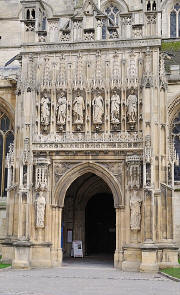
South Door |
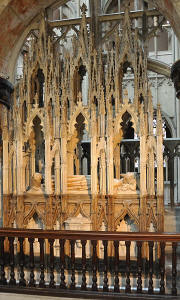
King Edward II Tomb |
 Click on small images
to see larger versions
Click on small images
to see larger versions |
|
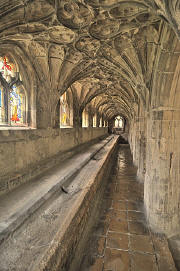
The Lavatorium
in the Cloisters |
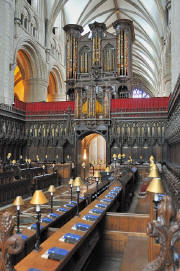
Choir and Organ
|
In one of the stain glass windows which
dates from 1350, is the earliest picture of the game of golf. There is also a
carved image of people playing a ball game, believed by some to be one of the
earliest images of medieval football. The great east window is the second largest
area of medieval glass in any British church window, measuring 72ft high by
38ft wide, it was put together in the mid 14th century and shows the monks view
of the divine order, the structure of their society in this life and
beyond. While historically important, they are not terribly photogenic, while
the Victorian windows, a number by Charles Kemp, each shows a colourful
scene with character and facial expressions that do offer the photographer a far
more interesting subject matter. Their images are a part of the history of
events in the cathedral.
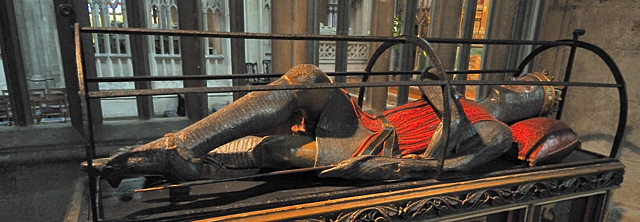

Memorial made in bog oak of
Robert, Duke of Normandy, the oldest son of William the Conqueror
| The cloisters have fan vaulting above all four
walks, not only spectacular but difficult to see how such a 3D image was carved.
The south walk has 20 study recesses or carrels, while a part of the north walk
has an extension, a long section of fan vaulted lavaterium, a sort of washing
place. The chapter house, comes off the east walk, and is unusually not that
exciting compared to the rest of this building, usually the chapter house is
second only to the church in splendour. Outside and around the back, north side you
will find some other abbey remains and a smaller set of cloisters that was
originally the hospital area within the abbey. Today it has a herb garden within
it, while the lager main cloisters has a peaceful garden and water feature. As
you walk around the outside, notice the windows for the chapels in the crypt and
the space under the alter of the lady chapel. Like many cathedrals you will find
it in a close with interesting period buildings, entrances being gateways or
archways, although there is also one gated road in.
|
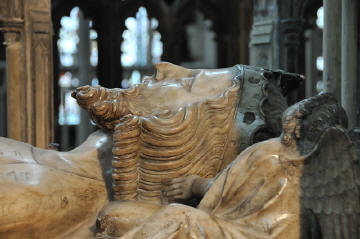
 King Edward II
King Edward II
Click on small image to
see larger version |
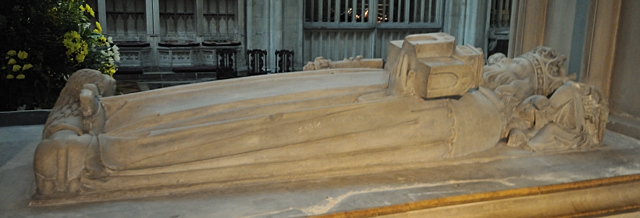

Stone effigy of Osric,
founder of first religious house in Gloucester
The original organ is from 1665, with original
highly decorated pipes, it sits on the top of the screen between the naive and
quire, visible from both sides. Entry is from the highly retorted and carved porch way and south door.
When you come to visit, you will find a
donation box, but no turnstiles, you don't have to buy a photo permit, but as
long as you drop at least £3 into the donation box, you can take photos. There
are guides around, and you are given a handout showing a brief idea of layout
and facts. A gift shop sells a range of other guides and souvenirs. We looked
around, exploring each part, before asking some questions of one of the guides
who was around, he took us down into the crypt, and we could, had we wanted, visited the treasury, and for £2 have gone up to the whispering gallery and
around to get closer at a higher level to the great east window.
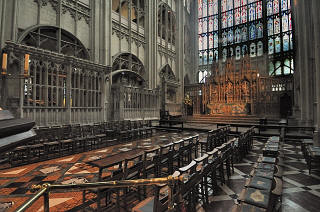
 |
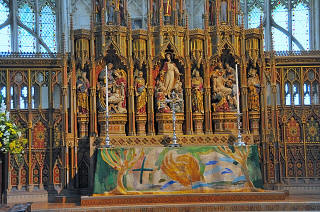
 |
|
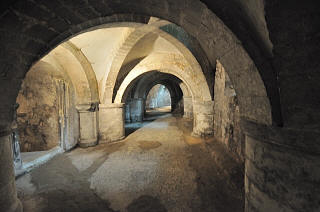

The Crypt |
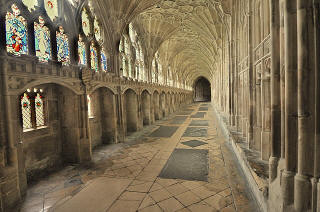

Cloisters with study areas |
|
 Click on small images
to see larger versions
Click on small images
to see larger versions |
| There is also a Tower tour, (not during winter months),
there are 269 steps to top of tower, providing a view
for up to 40 miles on a good day. Stopping off at the bell ringing chamber, and
again at the bell chamber on the way up. Make it to the top and back down the
269 steps again and for a £1 they will give you a certificate, if you want one.
I had on the day of my visit only two hours
available and this was not sufficient to include either the tower tour or
whispering gallery, having spent a lot of time on other features. Being very
near to me I can go back and do this another day.
I have visited many ruined abbeys, and many
cathedrals, each has special features, Gloucester is older in style to many, and
although it has some later additions you get a better idea of what the monks
would have seen so long ago. The cloisters in many cathedrals, where they exist
,have been reused, here they are not only the finest examples, but completely
clear, and as today they don't lead anywhere much, a lot of the time you will
find you have then to yourself.
|
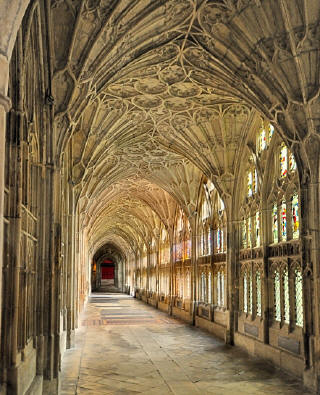

The Cloisters |
.
Planning Grid
|
Location: |
Gloucester Cathedral, Gloucester |
|
Grid Reference: |
SO831187 |
|
Getting there: |
Centre of Gloucester |
|
Access: |
In a close, easiest way
in - off Westgate Street pedestrian area. |
|
Parking: |
Public car parks (NCP
can be quite expensive) or further out for free and walk in. |
|
Facilities: |
WC, food, shop, guide
books, guides. |
|
Things To Do,
See and Photograph: |
Buildings, architecture, views. |
|
What to take: |
Tripod, level, wide angle lens. |
|
Nature highlights: |
None |
|
Address: |
Gloucester Cathedral
2 College Green
Gloucester |
|
Postcode: |
GL1 2LR |
|
Telephone: |
01452 528095 |
|
Opening times: |
In term time the
building is closed between 08:45 and 09.15 for school assembly.
Guided tours
| Days |
Guide Availability |
| Mon-Sat |
10.30am - 4.00pm |
| Sun |
12.00am - 2.30pm |
Treasury (closes part of winter months)
| Days |
Opening times |
| Mon-Fri |
10.30am - 4.00pm |
| Sat |
10.30am - 3.30pm |
| Sun |
Closed |
Exhibition and upper gallery (not open in winter months)
| Days |
Opening times |
| Mon-Fri |
10.30am - 4.00pm |
| Sat |
10.30am - 3.30pm |
| Sun |
Closed |
Tower tours (Not winter months) - some dates/times may change
due to other events. call to check if travelling some way.
| Mon-Tue |
2.30pm (school holidays only) |
| Wed-Fri |
2.30pm |
| Sat |
1.30pm and 2.30pm |
| Sun |
Closed |
| Bank Holiday |
1:30pm and 2:30pm |
|
|
Charges: |
No entry fees, but £3
donation suggested.
Photos allowed as long as you make at least a
£3 donation.
Treasury entry
- Free
£2 charge to
enter higher level to see glass window closer and exhibition. Children
with you no charge.
Adult £3; child £2 to join tour to top of tower. |
|
Photo Restrictions: |
Photos allowed as long as you make at least a £3
donation.
No restriction for own
use except no photos during/in services etc. |
|
Other Restrictions: |
None |
|
Special Needs Access: |
No problem to all of ground floor, ramps and lifts throughout |
|
Special Needs Facilities: |
|
|
Children Facilities: |
Ideal place for children, cloisters used in 3 Harry Potter films, and part
of cathedral used in Dr Who. |
|
Dogs Allowed: |
Guide dogs only I expect, otherwise ask. |
|
CIN Page Ref: |
Gloucester_Cathedral |
Date Updated: 09/2008 |
|

|
Please let us know any other information that we
can add to the Further information and Planning Grids or page and any errors that you discover. Before making a long trip to any location it is always
wise to double check the current information, websites like magazines may be
correct at the time the information is written, but things change and it is of
course impossible to double check all entries on a regular basis. If you have
any good photographs that you feel would improve the illustration of this page
then please let us have copies. In referring to this page it is helpful if you
quote the Page Ref at the bottom of the Planning Grid above. To print the
planning grid select it then right click and print the selected area.
Please submit information on locations you discover so
that this system continues to grow.
|